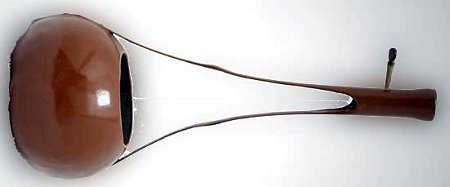The Stringed Instrument Database
E

Epinette Des Vosges
Alternative names:
Origin: Eastern France, 18th century.
Tuning: Often tuned to an open C chord.
Strings/Courses: No standard.
Further notes: Was taken by French immigrants to America. A similar instrument, the German Scheitholt was also taken by German immigrants to America and the two became the Dulcimer. The frets can either be diatonic or chromatic or a mixtre of both. Steel strings.
Scale Length: A wide variety. Usually between 450-680mm
Ekintong
orEcontin
- See Akintong

Ektara
Alternative names: Iktar, Ektar, Gopichand, Gobijeu
Origin: India
Tuning: N/A
Strings/Courses: 1/1
Further notes: Usually a metal string, but can also be nylon or anything else. The pitch is altered by pushing in the flexible sides.
Scale Length:

Endingidi
Alternative names: Endingiri, Eningiri, Indingiti.
Origin: Uganda.
Tuning: No standard.
Strings/Courses: 1/1
Further notes:
Scale Length: No standard.

Erhu
Alternative names: Nanhu
Origin: China, 10th century.
Tuning: D4, A4
Strings/Courses: 2/2
Further notes: Steel strings.
Scale Length: The standard is 380-400mm, but this is often altered slightly to the musician's taste.

Esraj
Alternative names: Israj
Origin: Bengal, India, 1800's.
Tuning: No absolute pitch, but the strings are tuned to set intervals depending on the ragas being played.
Strings/Courses: 4/4
Further notes:
Scale Length: 700mm.